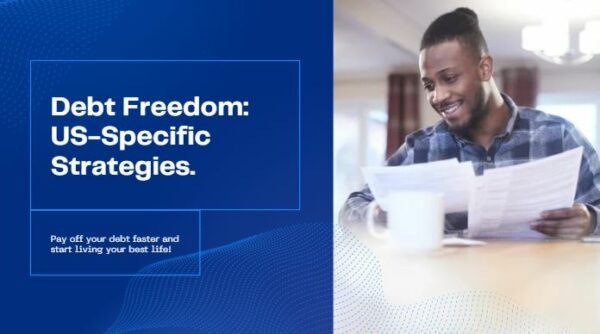Debt can feel like a heavy burden, weighing down on your finances and limiting your ability to achieve your financial goals.
Whether it’s credit card debt, student loans, or medical bills, being in debt can be stressful and overwhelming.
But the good news is, with the right strategies and determination, you can work towards becoming debt-free.
In the United States, there are specific strategies and resources available to help you pay off debt faster and regain control of your finances.
From budgeting techniques to debt repayment plans, understanding these tools can put you on the fast track to debt freedom.
In this article, we’ll explore US-specific strategies to pay off debt and provide official links to trusted resources along the way.

Understanding Your Debt
The first step to becoming debt-free is understanding your current financial situation. Take stock of all your debts, including credit card balances, student loans, car loans, and any other outstanding bills.
Make a list of each debt, noting the total amount owed, the interest rate, and the minimum monthly payment.
Once you have a clear picture of your debts, you can prioritize them based on factors such as interest rates, balances, and payment terms.
This will help you focus your efforts on paying off high-interest debts first, while still making minimum payments on other accounts to avoid late fees and penalties.
Creating a Budget
A budget is a powerful tool for managing your finances and paying off debt. Start by calculating your monthly income and expenses, including fixed costs like rent or mortgage payments, utilities, groceries, and transportation.
Then, identify areas where you can cut back on spending to free up extra money for debt repayment.
There are many budgeting methods to choose from, such as the 50/30/20 rule, where 50% of your income goes towards necessities, 30% towards discretionary spending, and 20% towards savings and debt repayment. Find a budgeting approach that works for you and stick to it.
Snowball vs. Avalanche Method
Two popular strategies for paying off debt are the snowball method and the avalanche method. With the snowball method, you focus on paying off your smallest debt first while making minimum payments on larger debts.
Once the smallest debt is paid off, you roll the payment amount into the next smallest debt, creating a snowball effect that accelerates debt repayment.
The avalanche method, on the other hand, involves tackling your debts in order of interest rate, starting with the highest-interest debt first.
By paying off high-interest debts early, you can save money on interest over time and pay off your debts more quickly.
Debt Consolidation
If you have multiple debts with high-interest rates, consolidating them into a single loan with a lower interest rate can help simplify your finances and save money on interest.
Debt consolidation loans are available from banks, credit unions, and online lenders, and can be used to pay off credit card balances, medical bills, and other unsecured debts.
Before consolidating your debts, it’s important to compare loan offers and carefully review the terms and conditions.
Make sure you understand the interest rate, repayment term, and any fees associated with the loan before signing on the dotted line.
Seeking Professional Help
If you’re struggling to manage your debts on your own, don’t hesitate to seek professional help. Credit counseling agencies offer free or low-cost services to help you develop a personalized debt repayment plan and negotiate with creditors on your behalf.
They can also provide financial education and budgeting assistance to help you avoid future debt problems.
Be cautious when choosing a credit counseling agency and make sure they are accredited by a reputable organization such as the National Foundation for Credit Counseling (NFCC) or the Financial Counseling Association of America (FCAA).
Avoid companies that charge high fees or make unrealistic promises about eliminating your debts.
Staying Motivated
Paying off debt takes time and discipline, but the rewards are well worth the effort. Stay motivated by setting achievable goals, celebrating small victories along the way, and visualizing the future financial freedom that awaits you.
Surround yourself with supportive friends and family members who can cheer you on and hold you accountable.
Remember, becoming debt-free is a journey, not a sprint. Stay focused on your long-term goals and don’t get discouraged by setbacks or obstacles along the way.
With determination and perseverance, you can overcome your debts and build a brighter financial future for yourself and your family.
Debt Payoff Strategies
Now that you understand your debts, let’s explore strategies to accelerate your payoff:
- The Debt Avalanche: This method tackles the highest interest rate debts first. By minimizing interest payments, you free up more money to throw at your remaining debts.
- The Debt Snowball: Here, you prioritize the smallest balances first. Each paid-off debt fuels your motivation and frees up extra cash to attack larger ones later.
- Debt Consolidation: Consider consolidating your debts into a single loan with a lower interest rate. This simplifies your repayment process and potentially saves money. However, be cautious of extending repayment terms, as it could drag out your debt-free timeline.
Boosting Your Debt Payoff Power
Here are some ways to generate extra cash and throw it towards your debt:
- Increase Your Income: Look for opportunities to earn more. Explore a side hustle, negotiate a raise, or take on a freelance project.
- Reduce Expenses: Analyze your spending habits. Can you cut back on dining out, subscriptions, or entertainment? Every dollar saved goes directly towards your debt.
- Budgeting: Create a budget that prioritizes debt repayment. Tools like Mint ([Mint budget]) or You Need A Budget (YNAB) ([YNAB]) can help.
Lifestyle Tweaks for Debt Freedom
Small lifestyle changes can free up significant funds for debt repayment:
- Embrace Frugal Living: Explore free or low-cost entertainment options like picnics, library visits, or game nights.
- Cook More at Home: Eating out adds up quickly. Explore budget-friendly recipes and pack lunches.
- Challenge Yourself with No-Spend Days: Dedicate specific days to spending nothing but essentials.
- Downsize Your Living: Consider moving to a smaller apartment or house to reduce rent or mortgage payments.
- Sell Unused Belongings: Declutter your home and turn unwanted items into cash through online marketplaces or garage sales.
Government Resources and Debt Relief Programs
The US government offers several resources to help with debt:
- Federal Student Loan Repayment: The Department of Education offers various repayment plans based on your income
- Consumer Financial Protection Bureau (CFPB): This agency provides resources on managing debt and resolving debt collection issues ([Consumer Financial Protection Bureau]).
Staying Motivated on Your Debt-Free Journey
Paying off debt requires dedication. Here are some tips to stay on track:
- Set Realistic Goals: Break down your larger debt payoff goal into smaller, achievable milestones. Celebrate each milestone to stay motivated.
- Track Your Progress: Monitor your progress towards your debt freedom goal. Seeing the numbers decrease can be a powerful motivator.
- Find a Support System: Talk to friends, family, or online communities for encouragement and accountability.
- Reward Yourself: Celebrate milestones with small, non-monetary rewards to keep yourself motivated.
Conclusion
Becoming debt-free is possible with the right strategies and resources. By understanding your debts, creating a budget, exploring debt repayment methods, and seeking professional help when needed, you can take control of your finances and work towards a debt-free future.
